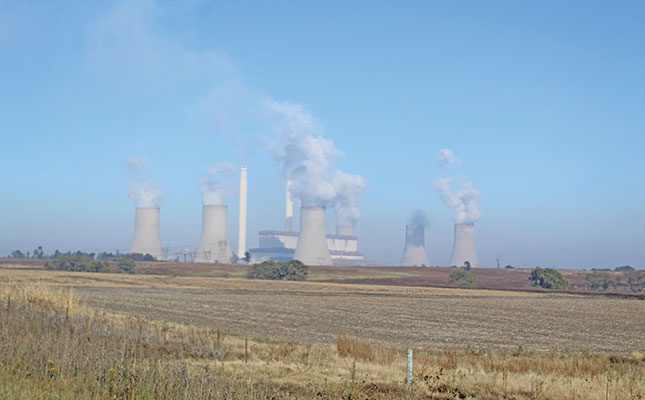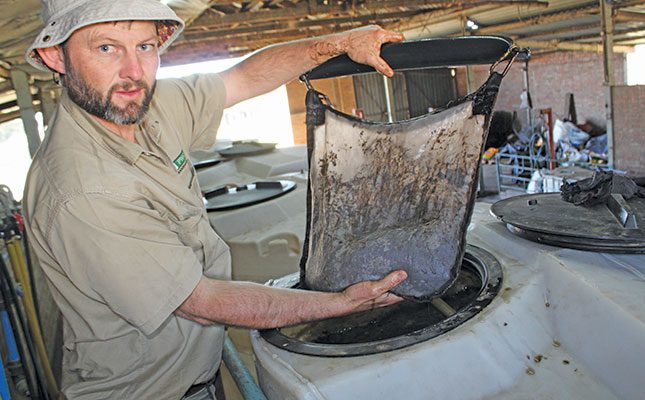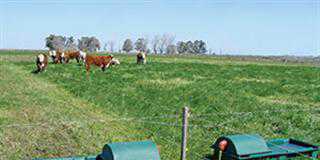
Photo: Lindi Botha
“Soil that has the texture of a chocolate sponge cake. That’s what I am working towards!” says Hendrik Odendaal, cradling a handful of freshly dug soil on his maize land near Standerton in Mpumalanga.
He certainly seems to have made progress; plant roots of various sizes from a diversity of cover crops drill down into the soil, creating aeration and pathways for water, and loosening up what would otherwise have been dense clay.
Earthworms and a host of other beneficial insects wriggle and crawl their way through the clumps, transporting nutrients and organic matter deeper into the soil profile.
Odendaal switched from conventional tillage to a no-till, regenerative agriculture system 16 years ago. Focusing on soil health, he has reduced herbicide and insecticide usage, and increased the carbon in his soils while still achieving industry-average yields on his maize and soya crops.
“The primary aim of converting from conventional tillage to no-till is to prevent disruption of the soil’s natural, delicate eco-system, and moisture loss from upending the soil into the sunlight,” explains Odendaal as he squeezes a handful of soil that is still wet from rain that fell a week ago.
“The hard part is to achieve loose soil without ripping by incorporating plant roots and insects to do the work instead. It takes time, but over the years I’ve been able to increase the health and carbon in my soil by leaving crop residues to decompose, planting cover crops to protect the soil, and feeding the whole system with worm tea and compost.”

Odendaal is one of an emerging community of regenerative agriculturists using a method of farming that could contribute significantly to South Africa’s goal to neutralise the country’s carbon emissions by mid-century, achieving ‘net-zero’ status. But how much carbon they end up eliminating depends on how government formulates policies to reach its net-zero goal.
As a signatory of the United Nations climate-focused Paris Agreement, South Africa aims to reach the global goal of carbon-neutrality— or ‘net zero’ emissions — by mid-century. This means emissions needs to be cut down as closely as possible to zero, with any remaining carbon removed from the atmosphere, through initiatives such as no-till, for example.
According to Grain SA, the country’s grain lands make up 6,2 million hectares and have the potential to become a carbon-capturing machine, removing eight million tons of carbon annually.
Dr Hendrik Smith, soil scientist at Cultivating Carbon, says that regenerative agriculture has the potential to save 1,3t of carbon per hectare annually through reduced emissions from the decreased consumption of diesel, lime and nitrogenous fertilisers, as well as an increase in soil organic carbon.
He adds that the soil’s carbon-capture potential, if farmers don’t till their lands, could absorb on average 0,75t of carbon per hectare per year, amounting to 4,6 million tons of carbon removed from the atmosphere annually.
How agriculture’s sequestration potential will contribute towards achieving carbon neutrality in South Africa remains murky, however. While carbon taxes for farmers are set to kick in in 2026 when the carbon tax law comes into play, industry experts lament that the details of who will be taxed and how are absent.
Other environmental policies informing carbon pollution and mop-up are also unclear, leaving farmers in the dark as to how legislation will affect them, the food value chain, and the cost and availability of food that reaches consumers.
The cost to remove carbon
Carbon taxes will threaten farmers’ profitability, according to Janse Rabie, Agri SA’s head of the Natural Resources Centre of Excellence and a representative of the agriculture sector on the United Nations’ global scientific body, the Intergovernmental Panel on Climate Change. Rabie says the bigger problem that government policies must solve is the cost of transitioning.
“Implements and technologies that reduce carbon footprints are not cheap, and the average farmer in South Africa can’t afford to transition. Audit costs to determine the carbon footprint and applicable taxes are high, and there won’t be any rebates for those who can’t prove their reductions.”
There is one potential benefit that could make expensive audits worth it in the long run, though, as seen on an avocado and macadamia farm near Tzaneen, Limpopo, where Johan van den Heever farms on 200ha. When farmers know where the biggest emissions come from, they can know where to make the most effective interventions.
Pointing to a lifeless pump house near his macadamia and avocado orchards, he says: “This is one of the biggest culprits in terms of the carbon footprint and the cost of farming. We use Eskom electricity to run the irrigation systems for the orchards. It costs us when the pumps run, but even more when there’s load-shedding, because we have to pay overtime for labourers to come in at night to get the pump house going when the power comes back on.”
Eskom’s woes have been a stumbling block for Van den Heever for many years, but it was only when he carried out a carbon emissions measurement exercise that the extent of the problem became clear.
“I quickly saw that emissions mean money, as emissions are mostly linked to fuel and electricity usage. So if I can reduce my footprint, my operating costs will come down too.”
Using the Confronting Climate Change initiative’s emissions measurement tool was an eye-opener for Van den Heever. By analysing workflow, the tool highlighted how unnecessary trips around the farm and into town pushed up emissions from tractors and bakkies.
“We’ve since implemented better planning and stricter enforcement of farm rules to reduce excess driving,” he explains.
Carrying through strategies for lowering carbon reduces operating costs. “But some of the biggest mitigation strategies come at an additional cost, which we can’t carry right now.”
Van den Heever’s biggest emissions reduction will come from switching to solar power.
The solar solution
Fruit farms require a substantial amount of power for irrigation pumps and operating packhouses. The non-profit organisation GreenCape lists cases in the deciduous fruit industry in the Western Cape where farmers have lowered their carbon footprints by installing solar power.
Ceres Fruit Growers, for example, generates 1 690 MW/year of solar power, avoiding emissions totalling 1 622t of carbon per year.
Ceres Koelkamers has avoided 839t of carbon per year by generating 848 MW/year of solar power.
Solar plants come at a significant capital cost, but they also pay for themselves over time due to the savings in Eskom costs, and in Van den Heever’s case, overtime pay. If an industry is already struggling to keep its head above water, however, any large expenses come under greater scrutiny.
The past season has been a nightmare, says Van den Heever. With commodity prices down and export fruit spoiling due to port delays, farmers like him suffered big financial losses.
“These are not problems that will be fixed in one season, and until we can return to better market conditions, reducing our carbon footprint through solar systems will have to wait.”
Although irrigation will still need to be pumped by Eskom power, with greater water-use efficiencies, his farm could still reduce power usage, and thereby emissions.
“On the average avocado farm, electricity for irrigation is the highest contributor to carbon emissions, followed by diesel and nitrogen fertiliser. By packing mulch or growing cover crops in the orchards, we not only prevent a lot of evaporation and keep the soil moist for longer, but also aid in improving soil health and over time, reducing the need for fertiliser. We also improve our soil carbon sequestration potential and enhance the biodiversity in the orchards.”
Avocado orchards take up around 17 000ha in South Africa. With a carbon-capturing potential of 0,3t/ha, as calculated by carbon project developer WeAct, avocado trees absorb 5 100t of carbon per annum. Fruit and nut orchards account for around 300 000ha, placing the carbon-capturing ability of South Africa’s food trees at 90 000t of carbon per annum.
The risk of punitive policies
Poorly thought-out carbon taxes might not bode well for food security, according to Rabie, as they would increase the cost of emissions-linked inputs such as fuel, energy and fertiliser. Input costs have already risen sharply in recent months, pushing up food prices.
Exporting sectors also have cause for alarm. With the EU limiting emissions from their own farmers, it is set to impose penalties for carbon-intensive imported products. Losing such important markets could mean these industries would have to shut down, placing the livelihoods of thousands at stake.
Rabie advocates for policies that will encourage and incentivise farmers to lower their carbon footprints, and use what they have at their disposal to mop up excess carbon from the atmosphere. “There have been talks about carbon tax deductions of up to 95% for farmers, but nothing has been finalised.”
The rise in input costs and the decreasing availability of Eskom power have inadvertently shifted farmers (or at least those who can afford it) towards lower carbon emissions. Rabie explains that agriculture is the only sector that has had a measured decrease in carbon emissions over the past decade.
“Precision farming that generally results in reduced fertiliser usage, no-till grain farming that aids carbon sequestration, and solar power have all reduced emissions in agriculture. Farmers are already on the right track, despite a lack of government incentives.”
As for the funds to create incentives for agriculture to sequester more carbon, Rabie is not hopeful that South Africa will use green financing promised to the country by developed nations at the annual UN-led climate change conference, the most recent of which took place in 2022 in Egypt, known as COP27.
“The money has yet to be received. But even then, government has noted that the money will be used to support Eskom in its transition to green energy. There have been no discussions about using the funds to ensure food security.”
Agriculture’s contribution to lowering South Africa’s carbon footprint can be significant, but it comes at a cost.
Gerhard van den Burgh, senior analyst at the Bureau for Food and Agricultural Policy, notes that although advances in technology and the increase in demand is bringing down costs for many carbon-reducing pathways, the pencil will need to be sharpened many times before the entire agriculture sector can afford to transition.
“This will require policies that are smartly structured to encourage greening, incentivise where necessary, and not punish food producers who don’t, or can’t, comply. The food value chain is under enormous pressure to make ends meet due to rising input costs. When consumers are facing food inflation of 18%, how can they still be expected to pay a carbon tax? From a farmer’s point of view, global competitiveness is already so marginal. There are no subsidies, and increasing load-shedding and theft. It’s not a logical argument to tax farmers to death.”
This story was produced with support from Internews’s Earth Journalism Network.










